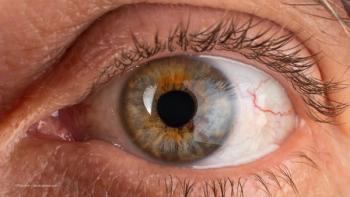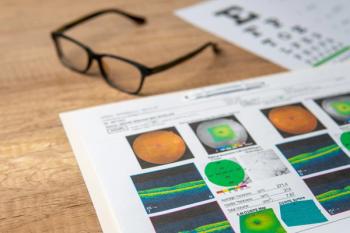
- May digital edition 2022
- Volume 14
- Issue 5
Navigating vision challenges in aviation
Optimizing eye care for pilots is crucial for safe flying.
This article will focus on vision tasks and challenges related to flying, several vision-related accidents, and practice pearls for optimizing eye care for pilots. Information about medical conditions, eye surgeries, medications, etc, can be found in the Federal Aviation Administration (FAA) Vision Standards Title 14, Part 67 of the Code of Federal Regulations (CFR)1 and the FAA Guide for Aviation Medical Examiners (AMEs).2
In 2019, there were an estimated 664,565 certificated (they are not referred to as licensed) pilots, including student pilots. The average age was 44.2 years.3
A pilot must meet established vision criteria to be legal to fly and may have a class 1, 2, or 3 flight medical certificate given by an Aviation Medical Examiner. Or they may choose a relatively new option called BasicMed, in which the Class 3 medical exam can be provided by a licensed physician.
Finally, if the pilot is exercising the limited sport pilot privileges, it is only necessary to have a valid driver’s license, which sets the vision standard.
Eye standards for the Class 3 medical certificate—the least restrictive of the 3 classes—are summarized as follows. The full description can be found in the CFR.
» Distance and near visual acuities of 20/40 or better in each eye separately. If corrective lenses (eyeglasses or contact lenses) are necessary for 20/40 vision, they must be worn.
» Ability to perceive those colors necessary for the safe performance of airman duties.
» No acute or chronic pathological condition of either eye or adnexa that interferes with the proper function of an eye that may reasonably be expected to progress to that degree, or that may reasonably be expected to be aggravated by flying.
Before a flight
A pilot prepares for flight by studying maps and weather information related to the intended time, route, and destination.
Aviation charts may be paper or digital, and the latter may be accessed via a computer, smart phone, iPad, etc.
The charts are densely populated with print and details in various sizes and colors (see Figure 1). The importance of the information is highlighted by the fact that aviation sectional charts for visual flight rules are published on a 56-day cycle.
Prior to entering the aircraft, the pilot will do a preflight safety inspection. This may require looking at areas from unusual postures; for example, the underside of a wing on a low-wing aircraft (see Figure 2).
Inside the cockpit, the pilot can be faced with a complex array of instruments, lights, switches, and placards at a variety of distances, including overhead, across the breadth of the panel (dashboard), and on or near the floor (see Figure 3, below). The instrumentation displays may be digital or analog of various colors and sizes.
Airport environment
There are many signs, lights, and markings on or near runways and taxiways that indicate position and directions for a pilot. These vary in size, color, and location, and some are even painted on the runway or taxiway surface.
Navigating around a large unfamiliar airport can be visually challenging during the day and especially at night.
Runway incursions in which a plane taxis onto an active runway without clearance are a constant aviation problem. A landing or departing aircraft may be traveling more than 100 mph and be unable to make sudden adjustments to avoid a collision.
A related problem is landing on the wrong surface; for example, landing on a taxiway instead of a runway or landing on the wrong runway.
In the air
During flight, the pilot is constantly monitoring the instruments inside the cockpit, navigation charts, and displays. However, attention is mainly directed outside to identify navigation landmarks, and especially to avoid obstacles in the flight path, such as terrain, tall antennas, and other aircraft.
An exception occurs during instrument flight in which attention is (almost) exclusively devoted to the instrument panel.
The view outside changes with the season, weather, terrain, and time of day. A pilot may also travel hundreds of miles on a typical flight and encounter a variety of conditions along the way within a relatively short period of time.
Fatalities
A leading cause of aviation fatalities is spatial disorientation, including somatogravic illusions caused by loss of visual references. This usually happens when a flight under visual conditions continues into conditions of limited visibility (see Figure 4).
This was determined to be a factor in the helicopter crash that killed basketball player Kobe Bryant and others.4
Lighting
Bright light levels and glare are predominant features of flight during daylight hours (see Figure 5). Other aircraft are surprisingly difficult to see when flying during the day, even if you know where they are supposedly located.
Flight takes place in 3-dimensional space in which other planes may be above or below and descending or climbing in any direction.
Weather
Weather conditions permitting, it is the pilot’s responsibility to maintain vigilance, so as to see and avoid other aircraft.5 This applies to more than other aircraft and includes terrain, towers, and other obstacles—even wildlife; for example, birds or deer on or near a runway when landing or taking off.
Visual acuity
The visual acuity needed to avoid midair collisions is dynamic as well as static. Airplanes may travel at high speeds and 2 general aviation planes on a head-on collision course may be traveling at 120 mph each, hence closing at 240 mph.
Two jets might close at a net 1000 mph or more. If 1 aircraft was masked even for a second in the blur zone of a progressive addition lens, the result could be fatal. However, most mid-air collisions are not head-on and generally involve a faster aircraft overtaking 1 that is slower.6
Night vision
At night, there is a loss of many visual ground references important for safe flight. Airplanes flying at night are required to have position lights on the wingtips and a strobe or rotating red beacon. This makes them somewhat more visible than they are during the day unless they are against a background of city lights.
Wingtip position lights are red (left) and green (right), and recognizing the physical relationship between the colors indicates whether an aircraft is approaching or receding.
Night vision may be hampered by inadequate dark adaptation after prolonged light exposure during the day. Therefore, wearing tinted lenses during the day may prove beneficial for night flight.
Altitude
Altitude can adversely affect vision. The retina has a high metabolic demand, and altitude-induced hypoxia can adversely affect retinal function including by reducing color perception in low light levels.7,8
Landing
Near the end of a flight, vision and visual attention may be adversely affected by fatigue and hypoxia. It is arguably the time when good vision is most needed because air traffic density is generally greater near airports.
This is a busy time for the pilot, who must configure the aircraft for landing, watch for other aircraft in the traffic pattern, and watch the instruments and approaching runway to establish the correct descent.
Descent guidance may be provided by instruments in the cockpit and lighting systems on the ground that use a horizontal array of red and white lights that indicate if the aircraft is above or below the ideal angle of approach (see Figure 6). Impaired color vision has been a factor in aviation accidents.
See “
REFERENCES
1. e-CFR. Code of Federal Regulations. Title 14. Part 67 - Medical standards and certification. Updated March 17, 2022. Accessed December 19, 2021.
2. Federal Aviation Administration. Guide for aviation medical examiners. Updated February 22, 2022. Accessed January 9, 2022
3. Federal Aviation Administration. U.S. civil airmen statistics. Accessed March 27, 2022.
4. AOPA Foundation. NTSB faults pilot’s decisions in Bryant crash. February 20, 2021. Accessed March 27, 2022.
5. e-CFR. Code of Federal Regulations. Title 14. 91.113 Right-of-way rules: except water operations. Updated March 17, 2022. Accessed March 27, 2022.
6. Federal Aviation Administration. How to avoid a mid air collision - P-8740-51. Accessed March 27, 2022.
7. Connolly DM, et al. Mild hypoxia impairs chromatic sensitivity in the mesopic range. Invest Ophthalmol Vis Sci. 2008 Feb;49(2):820-827. doi:10.1167/iovs.07-1004. PMID: 1823503
8. Connolly, DM et al. Oxygenation state and twilight vision at 2438 m. Aviat Space Environ Med. 2011 Jan;82(1):2-8. doi:10.3357/asem.2904.2011.
9. National Transportation Safety Board. Investigation reports. Accessed March 27, 2022. https://www.ntsb.gov/investigations/AccidentReports/Pages/Reports.aspx?mode=Aviation
10. National Transportation Safety Board. Aircraft accident report. Delta Airlines flight 554. October 19, 1996. Accessed March 27, 2022..
11. National Transportation Safety Board. Aircraft accident report. Federal Express flight 1478. Boeing 727-232. July 26, 2002. Accessed March 27, 2022.
12. Aviation Safety Network. Aircraft accident report. Allegheny Airlines. Convair CV-580. December 24, 1968. Accessed March 27, 2022.
13. Federal Aviation Administration. Guide for aviation medical examiners – Pharmaceuticals (Therapeutic medications) Do not issue - do not fly. Updated February 19, 2021. Accessed March 27, 2022.
14. Federal Aviation Administration. Pilot medical certification questions and answers. Updated April 16, 2013. Accessed March 27. 2022.
15. Federal Aviation Administration. Disease protocols. Binocular multifocal and accommodating devices. Updated April 16, 2013. Accessed March 27. 2022.
Articles in this issue
over 3 years ago
Water biology plays important role in healthover 3 years ago
2022 updates to ADA standards of care for patients with diabetesover 3 years ago
Phakic IOL implantation: Visual and refractive outcomesover 3 years ago
Compounded medications in ophthalmic patient careover 3 years ago
Expecting the unexpected in ocular casesover 3 years ago
What’s hot (and not) in retinal newsalmost 4 years ago
Combatting dry eye during contact lens wearalmost 4 years ago
Glaucoma: More pressures than meet the eyeNewsletter
Want more insights like this? Subscribe to Optometry Times and get clinical pearls and practice tips delivered straight to your inbox.





